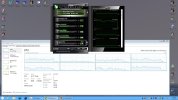I just got back home and it was not all that good, mainly because I messed up and let some malware into a brand new system. I ended up having to do a complete format and reinstall. 
Last year I put together an FM2+ system using the 6800K Richland apu.
This year I put together another one using the 7850K Kaveri apu.
If I build another one next year it might have the rumored Carrizo apu in it.
These are good mid range rigs with a nice upgrade path. Recommended video cards for them are the R9 270X and the R9 290 because they are Mantle compatible. Plus their performance should perk up when HSA becomes available.
Sorry Thagarr, but I will never buy another Intel cpu as they are just gouging us with their prices IMHO.
Here is a screenie of HOOCOT loads on my system. As you can see the cpu is loafing and the poor little 280X is pretty much running flat out. So it appears the video card is more important than the cpu.

Last year I put together an FM2+ system using the 6800K Richland apu.
This year I put together another one using the 7850K Kaveri apu.
If I build another one next year it might have the rumored Carrizo apu in it.
These are good mid range rigs with a nice upgrade path. Recommended video cards for them are the R9 270X and the R9 290 because they are Mantle compatible. Plus their performance should perk up when HSA becomes available.
Sorry Thagarr, but I will never buy another Intel cpu as they are just gouging us with their prices IMHO.
Here is a screenie of HOOCOT loads on my system. As you can see the cpu is loafing and the poor little 280X is pretty much running flat out. So it appears the video card is more important than the cpu.















